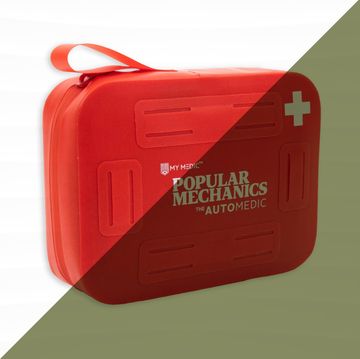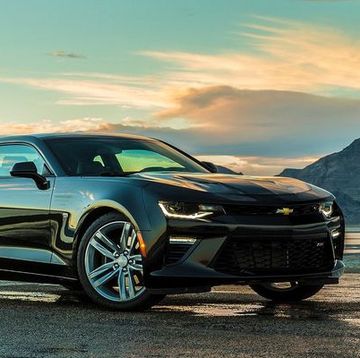Lompoc, Calif. — It's not where anyone would expect to find a research lab—a small hillside ranch and vineyard at the end of a half-paved road in the northern, rural part of California's Santa Barbara County. Even if you get through the front gate, it's easy to drive right past where all the mad science is going on. After all, it's just a pole barn, and, from the outside, it looks overstuffed with enough hay to feed the ranch's five horses for a year. But behind that hay is where Derek McLeish, with occasional help from his three brothers, has built and continues to develop the world's fastest car powered by compressed air.
"I always want to do something different," McLeish, an athletic 61, explains, "and when I heard there was a guy who was going to try and set at a record at Bonneville with a car powered by a rubber band, I thought about what I could do instead. Compressed air is what I came up with."
McLeish comes to this self-imposed project after a career that includes a decade as an executive at Gillette, then 14 years at Atari, and a score of entrepreneurial ventures, including a company he co-founded called Carbon Sciences that's striving to convert carbon dioxide into usable fuel. Maybe more importantly, however, he also comes to it after a boyhood spent racing motorcycles in his native Argentina and a decade chasing (and capturing plenty of) landspeed records at the Bonneville Salt Flats.
Something Completely Different
Compressed air as a power source is nothing new. Its simplest form is the toy Stomp Rockets we all played with as kids. You remember: a plastic bellows on one end of an air hose leading to a vertical standing launch tube on the other end. A lightweight "rocket" fits over the launch tube, and when the bellows are stomped on, a blast of compressed-air travels through the hose and thrusts the rocket skyward. The basic principles of the Stomp Rocket apply to McLeish's engine—only instead of pushing a piece of styled foam, the air pushes a piston which turns a crank. And instead of a foot slamming on a bellows, the compressed air is stored in pressure tanks.
"Mickey Thompson had tried building a compressed-air engine back in the '60s powered by 16 scuba tanks," McLeish recalls. "It's a great energy storage device. There are plans in Italy and India to use it. You could fill the tanks at night during off-peak hours when the electricity rates are cheaper. Then have power through the day off the tanks."
To build his compressed-air engine, McLeish started with the 998-cc DOHC, four-valve, 90-degree V-twin Honda had used to power its 2000 to 2006 RC51 superbike. "I needed a big cylinder and I happened to have an RC51 engine," McLeish says. But he didn't need two cylinders, so a bob weight at the end of a connecting rod replaces one of the pistons, and a plate on the crankcase covers where a cylinder barrel once sat.
Creative Use of Familiar Parts
Compressed air, stored at 3500 psi in three scuba tanks, enters the McLeish engine's cylinder through what was the spark-plug hole at the top of the remaining cylinder. That was the easy part. Getting it to run right took some brainwork. "I had three challenges," McLeish says. "How do I throttle it? How do I time it? And how do I regulate it?"
Coming up with a throttle took a lot of experimentation, but the solution was a simple ball check valve—like what you might find in an irrigation system. McLeish simply added a return spring and linked it to the accelerator pedal.
Two conventional high-pressure regulators were used to meter the air leaving the tanks. That, at least at the time, seemed like a straightforward solution.
Getting the timing right was the greatest hurdle. "I looked at using solenoids," McLeish says, "but we couldn't find ones that would close fast enough. Eventually what we came up with is what I call a 'tubular rotary valve.'"
McLeish's tubular rotary valve is basically a piece of pipe with a hole in it mounted to the end of engine crankshaft. As the pipe spins in its housing, it allows the air through from the input hose to the hose that runs to the top of the cylinder. Between hose bosses, the valve is closed.
Every down stroke of the McLeish engine is a power stroke. And every upstroke is an exhaust stroke—with what were the two original intake valves alternating with the two original exhaust valves in emptying the cylinder of compressed air between strokes. The only emission is air.
"The compressed air enters the cylinder from 5 degrees past top dead center," McLeish says, "and it keeps rushing in until the piston is at the bottom. We're pushing it in at 250 psi and that's good for 60 hp per bottle per minute."
The resulting power then travels through the original RC51 six-speed manual transmission and on to the drive wheels. At Bonneville, where most vehicles are push-started anyhow, the entire course was run in sixth gear.
"It sounds like Chitty-Chitty Bang-Bang," says McLeish of the engine's exhaust note of rapid pops.
And a Body to Put It All In
Of course an engine this unique can't go into just any car. McLeish's exquisitely small, steel tube-framed "Silver Rod" can be configured as either a streamlined motorcycle or as an open-wheel "lakester," depending on which axle assemblies and wheels are bolted in. "The Motorcycle Department decided they didn't want to deal with an Omega-class (alternative-energy powerplant), so we decided to run it as a lakester," McLeish says.
Despite the fact that there's nothing on board that is likely to ignite, McLeish wore the required fireproof suit when he wedged himself aboard the Silver Rod for its run at Bonneville Speed Week last August with the compressed-air engine. Laying almost flat in the car, McLeish can only see what's directly in front of him through the slit of his helmet, but on the Flats, there's nothing in front of him except salt.
"The only question I had was whether we had enough energy to make it all the way over the course," McLeish recalls. Starting with 3500 psi in each of the tanks and running them down to 250 psi, he figured he'd be able to cover the short, two-mile course. And if he could make a complete run, he was guaranteed to set a record.
Except for its chug-chug sound and, well, low speed, McLeish's run in the compressed-air powered Silver Rod was uneventful—and he topped out at a scorching 54.058 mph. Based on his two-way average speed of 46.723 mph, he set a record.
"The regulators were fighting each other," McLeish says. "If we could have got more air out of the bottles we could have gone much faster."
Of course there is energy expended to fill a compressed-air bottle. It's that stored energy that's released from the bottles that powers a compressed air engine. So maybe the best way to understand compressed air as a power source is to think of the bottles as batteries that store mechanical instead of electrical energy. The trouble is that it takes a lot of compressed-air cylinders to obtain meaningful range and heat losses sap overall efficiency.
The practical application of compressed air as a power store in the future is interesting to contemplate. But for the moment, Derek McLeish has a purely impractical goal in mind. "I know we can go 300 mph on compressed air," he says. "I'm sure of it."

John Pearley Huffman has been writing about cars since 1990 and is getting okay at it. Besides Car and Driver, his work has appeared in the New York Times and more than 100 automotive publications and websites. A graduate of UC Santa Barbara, he still lives near that campus with his wife and two children. He owns a pair of Toyota Tundras and two Siberian huskies. He used to have a Nova and a Camaro.













